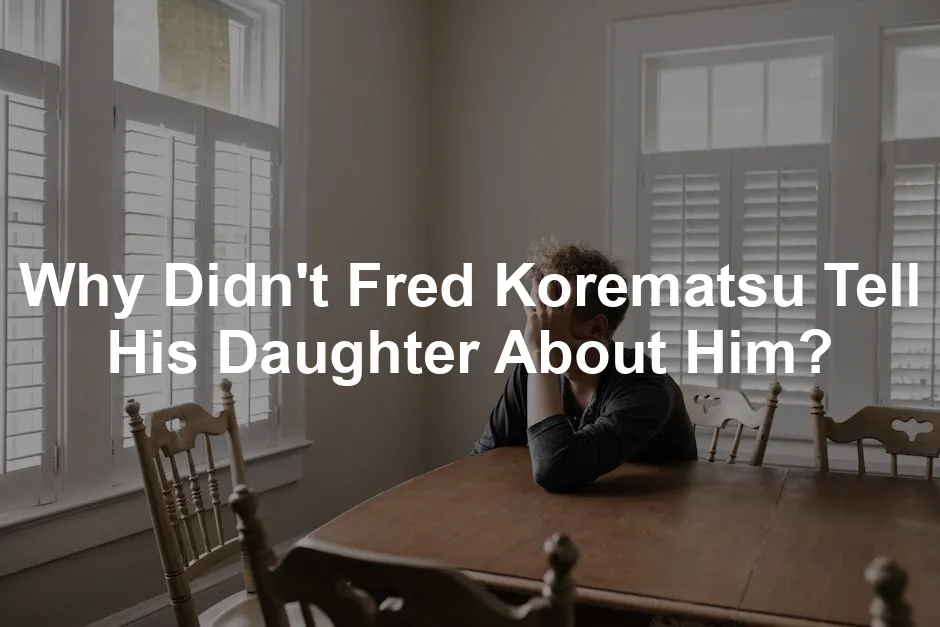
Why Didn’t Fred Korematsu Tell His Daughter About Him?
Introduction
Fred Korematsu stands as a pivotal figure in American civil rights history. His courageous legal battle against Japanese American internment during WWII highlighted grave injustices. Yet, a personal aspect of his journey remains shrouded in silence—his relationship with his daughter. Why did he choose not to share his experiences with her? Speaking of powerful stories, if you want to dive deeper into the world of civil rights, check out Just Mercy: A Story of Justice and Redemption. It’s a gripping read that echoes the fight for justice that Korematsu embodied.
The Historical Context of Korematsu’s Silence
The Impact of WWII on Japanese Americans
During World War II, the U.S. government forcibly interned over 120,000 Japanese Americans. This decision stemmed from fear and prejudice following the attack on Pearl Harbor. Many families were uprooted from their homes, facing harsh living conditions in camps. The psychological effects of this experience were profound. Survivors often dealt with trauma, stigma, and a sense of loss. The Japanese American community found itself grappling with shame and anger. These feelings were compounded by the broader societal implications, as many Americans viewed Japanese Americans with suspicion. Even after the war, the stigma lingered, affecting relationships and identities for generations. This painful legacy influenced Fred Korematsu’s silence about his own experiences. He carried the weight of his past, feeling a sense of responsibility for the stigma faced by his community. If you want to understand the historical context better, consider reading The Color of Law: A Forgotten History of How Our Government Segregated America. It’s an eye-opener!
Fred Korematsu’s Defiance and Arrest
Fred Korematsu’s resistance to internment was a bold act of defiance. In 1942, he refused to comply with the government’s order to relocate to an internment camp. His actions were not just personal; they became pivotal in a larger civil rights movement. Korematsu changed his appearance and adopted a false identity to evade capture. However, he was arrested in San Leandro, California, and taken into custody. This arrest led to a landmark legal battle. Korematsu’s case, Korematsu v. United States, reached the Supreme Court, where he challenged the constitutionality of internment. Unfortunately, the Court upheld his conviction, citing military necessity as justification. This decision marked a dark chapter in American history, highlighting the fragile nature of civil liberties during wartime. If you’re interested in learning about the importance of standing up against injustice, The Subtle Art of Not Giving a F*ck by Mark Manson might just be the kick in the pants you need.
The Personal Struggles of Fred Korematsu
The Burden of Shame and Guilt
Fred Korematsu carried a heavy burden throughout his life. After losing his Supreme Court case, he felt immense shame. This loss wasn’t just a personal defeat; it affected his entire family. He believed that his fight had brought stigma to them. The weight of this guilt likely influenced his decision to keep his past hidden from his daughter. Sharing such painful memories would mean confronting his own perceived failure. For many years, he felt responsible for the internment experience and its repercussions. This internal struggle made it harder for him to discuss his history, a history that shaped not only his identity but also the legacy he wished to protect. To help ease that burden, many find comfort in mindfulness and meditation. Consider checking out a Yoga Mat to start your own journey.
Family Dynamics and Cultural Expectations
Cultural expectations played a significant role in Korematsu’s silence. Within the Japanese American community, discussing the internment was often taboo. Many families faced shame and stigma, which made open conversation difficult. Fred’s relationship with his wife and children was influenced by these dynamics. He wanted to shield them from the pain he endured. This instinct to protect his family from embarrassment likely contributed to his reluctance to share his experiences. Additionally, his children grew up in a different environment, where social issues were more openly discussed. As a result, the gap between their understanding and his lived experience created a barrier. The combination of cultural pressures and family dynamics shaped the silence that enveloped their home. If you want to explore more about family dynamics, consider reading The 7 Habits of Highly Effective People. It’s a great guide for improving personal and family relationships.
Cultural expectations can lead to increased pressure in society, affecting family dynamics and personal relationships. why do cultural expectations lead to increased pressure in society
Karen Korematsu’s Discovery
Learning About Her Father’s Legacy
Karen Korematsu’s life changed during high school. One day, a friend presented a report on the case Korematsu v. United States. As she listened, her heart raced. “That’s my name!” she thought, feeling a mix of pride and confusion. After class, she confronted her father about this revelation. He seemed taken aback and replied simply, “It happened a long time ago.” His expression revealed deep hurt, making it clear that discussing his past was painful for him. This moment marked the beginning of Karen’s journey to understand her father’s legacy and the silence that had surrounded it for so long. To further explore the themes of identity and legacy, consider reading Between the World and Me by Ta-Nehisi Coates.
The Emotional Impact on Karen
Learning about her father’s past hit Karen hard. It shook her perception of him. The man she admired was also a civil rights hero, but he had kept this part of his life hidden. Confusion and betrayal washed over her. Why hadn’t he shared his story? She felt as if a wall separated them, built from unspoken pain. Karen grappled with her father’s shame and fear, realizing that these emotions shaped their relationship. The silence that once felt normal now seemed like a barrier to understanding the man behind the legend. This emotional turmoil fueled her desire to honor his legacy and share their story with the world. If you’re curious about stories of resilience, I recommend The Immortal Life of Henrietta Lacks. It’s a fascinating tale of medical ethics and the impact of one woman’s life.
The Legacy of Fred Korematsu
Korematsu’s Later Activism
After his internment, Fred Korematsu became a passionate advocate for civil rights. He dedicated his life to educating others about the injustices faced by Japanese Americans. He traveled across the country, sharing his story and emphasizing the importance of civil liberties. His efforts contributed to raising awareness about racial discrimination and government overreach. In 2010, California recognized his legacy by establishing Fred Korematsu Day, celebrated annually on January 30. This day honors his courage and serves as a reminder of the need to protect civil rights for all. His legacy continues to inspire new generations to stand against injustice and fight for equality. If you’re interested in learning more about activism, check out The Art of War by Sun Tzu. It’s a classic on strategy and leadership.
The Role of the Korematsu Institute
The Fred T. Korematsu Institute, founded by his daughter Karen Korematsu, promotes civil rights through education and advocacy. The institute aims to ensure that Korematsu’s story is not forgotten. Its mission focuses on raising awareness about the dangers of discrimination and the importance of safeguarding liberties. The institute has developed educational resources for teachers and students, helping to instill values of justice and equality. By sharing her father’s experiences, Karen Korematsu hopes to empower young people to become advocates for civil rights. Through its programs, the institute continues to honor Fred Korematsu’s legacy, inspiring action against injustice today. Speaking of empowerment, if you’re looking for ways to improve your focus and productivity, consider getting an Echo Dot (5th Gen). It can set reminders, play music, and even answer your questions!
Understanding trauma can help us recognize why certain individuals may be more appealing or relatable. why are traumatized people attractive
Conclusion
Fred Korematsu’s life teaches us valuable lessons about standing up for civil rights. His journey illustrates the importance of sharing personal histories, especially those that bear the weight of silence. This silence can impact family relationships deeply. By learning from Korematsu’s story, we can foster understanding and advocate for justice in today’s world. Let’s honor his legacy by raising our voices against injustice and supporting civil rights for everyone. For those looking to unwind after a long day of advocacy, a Weighted Blanket can provide comfort and relaxation.
Please let us know what you think about our content by leaving a comment down below!
Thank you for reading till here 🙂
All images from Pexels




